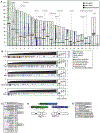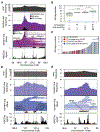Genomic Hallmarks and Structural Variation in Metastatic Prostate Cancer
- PMID: 30033370
- PMCID: PMC6425931
- DOI: 10.1016/j.cell.2018.06.039
Genomic Hallmarks and Structural Variation in Metastatic Prostate Cancer
Erratum in
-
Genomic Hallmarks and Structural Variation in Metastatic Prostate Cancer.Cell. 2018 Oct 18;175(3):889. doi: 10.1016/j.cell.2018.10.019. Cell. 2018. PMID: 30340047 No abstract available.
Abstract
While mutations affecting protein-coding regions have been examined across many cancers, structural variants at the genome-wide level are still poorly defined. Through integrative deep whole-genome and -transcriptome analysis of 101 castration-resistant prostate cancer metastases (109X tumor/38X normal coverage), we identified structural variants altering critical regulators of tumorigenesis and progression not detectable by exome approaches. Notably, we observed amplification of an intergenic enhancer region 624 kb upstream of the androgen receptor (AR) in 81% of patients, correlating with increased AR expression. Tandem duplication hotspots also occur near MYC, in lncRNAs associated with post-translational MYC regulation. Classes of structural variations were linked to distinct DNA repair deficiencies, suggesting their etiology, including associations of CDK12 mutation with tandem duplications, TP53 inactivation with inverted rearrangements and chromothripsis, and BRCA2 inactivation with deletions. Together, these observations provide a comprehensive view of how structural variations affect critical regulators in metastatic prostate cancer.
Keywords: BRCA2; androgen receptor; castration resistant prostate cancer; chromothripsis; gene fusion; genomics; metastases; structural variation; tandem duplication; whole-genome sequencing.
Copyright © 2018 Elsevier Inc. All rights reserved.
Conflict of interest statement
DECLARATION OF INTERESTS
A.M.C. is on the scientific advisory board of Tempus. F.Y.F. is co-founder of PFS Genomics. R.K.C., D.T.C., K.F., J.S.G., J. H., A.L., J.S., S.B., and P.F. are employees of Illumina Inc and hold stock in the company. The University of Michigan has been issued a patent on ETS gene fusions in prostate cancer on which A.M.C. and S.A.T. are co-inventors. The diagnostic field of use has been licensed to Hologic/Gen-Probe, Inc., which has sublicensed rights to Roche/Ventana Medical Systems. S.A.T. has an unrelated sponsored research agreement with Astellas. S.A.T. has served as a consultant for and received honoraria from Almac Diagnostics, Janssen, and Astellas/Medivation. S.A.T. is a co-founder of, consultant for and Laboratory Director of Strata Oncology.
Figures





Comment in
-
Sequence of events in prostate cancer.Nature. 2018 Aug;560(7720):557-559. doi: 10.1038/d41586-018-06029-5. Nature. 2018. PMID: 30143757 No abstract available.
References
-
- Aggarwal R, Beer TM, Gleave M, Stuart JM, Rettig M, Evans CP, Youngren J, Alumkal JJ, Huang J, Thomas G, et al. (2016). Targeting Adaptive Pathways in Metastatic Treatment-Resistant Prostate Cancer: Update on the Stand Up 2 Cancer/Prostate Cancer Foundation-Supported West Coast Prostate Cancer Dream Team. European Urology Focus 2, 469–471. - PubMed
-
- Amundadottir LT, Sulem P, Gudmundsson J, Helgason A, Baker A, Agnarsson BA, Sigurdsson A, Benediktsdottir KR, Cazier JB, Sainz J, et al. (2006). A common variant associated with prostate cancer in European and African populations. Nat Genet 38, 652–658. - PubMed
Publication types
MeSH terms
Substances
Grants and funding
LinkOut - more resources
Full Text Sources
Other Literature Sources
Medical
Research Materials
Miscellaneous

